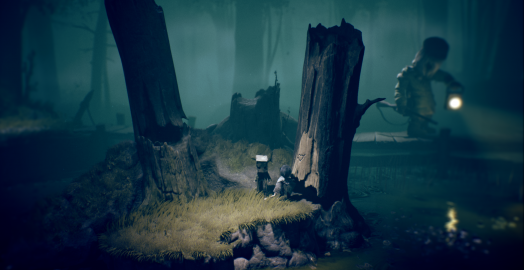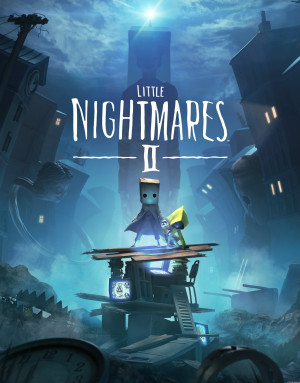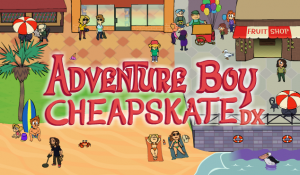Review for Little Nightmares II

We often toss around words like “dream-like” to describe anything strange and surreal, but rarely if ever have I encountered a game that felt as legitimately like a real dream as Little Nightmares. A very creepy dream, to be sure, as its title would suggest. But unlike many games that seek to tap into our subconscious fears by simply overdoing the weirdness or terror quotients, Tarsier’s 2017 survival-horror-stealth-adventure-puzzle-platformer mutation felt grounded enough in reality to feel real, yet so eerily unnatural and shrouded in darkness around the edges as to feel completely otherworldly – in other words, just like a nightmare. Gameplay-wise it could be a bit limited, but it was a masterclass in establishing a horrifically thrilling atmosphere.
Nearly four years later, along comes its sequel, and while it hasn’t done much to correct the weaknesses, such as controls that aren’t quite up to the task of the most punishing physical elements, and an over-reliance on unfair deaths at times, it certainly has all the strengths of its predecessor in creating a series of deliciously disturbing environments and characters to sneak, race, climb or puzzle your way past. For (mostly) better and (marginally) worse, then, Little Nightmares II ends up feeling less like a whole new adventure and much more like a recurring dream with some of the parts brilliantly rearranged.
Very little can be said about the story, not so much for fear of spoilers but because you simply won’t know anything, even by the end. (Ever wake up from a nightmare and marveled at how rational and coherent it was? Exactly.) This time you play as a young boy with bare feet, rolled-up old-timey trousers, a knee-length overcoat and a paper bag with cut-out holes over his head. His name is supposedly Mono, though without a single word spoken throughout the entire game, that’s never actually established. He doesn’t remain “mono” for long, in any case, as fairly early on you’ll encounter a frightened little girl about his age and work to win her trust so that she’ll join you on this surreal and perilous journey. Her identity is never revealed, though I will say that a yellow raincoat is eventually involved. (If you’re thinking “spoiler!” right there, that’s only because you’ve jumped to conclusions that may or may not be remotely true. It’s ALL left open to interpretation.)
I was grateful for the company while it lasted, as even though she never communicates and only rarely pitches in to perform dual-character actions (you have the ability to hold her hand and call her to you, though these are almost never needed), the main environments in Little Nightmares II – a remote country house, a school, a hospital and an apartment block, the latter three all separated by rain-drenched sections of city streets and rooftops in between – are not places you want to be all by yourself. Except often you end up alone anyway, as you must venture off – frequently thanks to a boost only your companion can provide – to find a needed item and a new access point to be reunited and continue on your way together.
Each time I left the little girl behind, I missed her comforting presence because this game is creepy. Not because of cheap jump scares, but due to hard-earned trepidation and stress-inducing suspense. Entire suits of clothes are left behind as if their former owners were suddenly raptured out of existence. Mannequin torsos and detached limbs are everywhere, including hanging from the ceiling. Bags filled with decomposing bodies are swarmed by flies. Grotesque figures stitched together from spare parts – flesh or otherwise – sit posed at a dinner table. A noose hangs ominously with scattered shoes beneath it. Even the children’s toys are hideously deformed. And it’s all so dark. Some rooms are pitch black, illuminated only by the beam of your flashlight once you’ve acquired it, but even the brightest of rooms seem to have just a single dim light source illuminating them. There’s just enough visibility to be convinced that something is lurking there, waiting. And sometimes there is.
Each general location is guarded by a “boss,” for lack of a better word – human in a sense, but only in the most twisted and distorted way, like the school teacher whose neck extends to great lengths to search for troublemaking visitors, or the glutinous blob of a doctor who attaches himself to the ceiling in search of noisy prey. They’re freaky just to look at, and infinitely more so when they’re alerted to your presence. Either you have mere seconds to find the nearest hiding place, or you’d best prepare for a scripted chase sequence, dodging obstacles and staying out of harm’s way. These encounters aren’t frequent, but they’re regular enough to keep you filled with dread of the next one that could be just around the corner.
These aren’t the only monsters you’ll need to contend with: porcelain-headed school children, disembodied hands, animated dummies and hypnotically deranged adults, among others, all stand (or sit, or crawl) in your way as well. Some you can fight with your meagre ability to swing a handily placed hammer or crowbar, but most you’ll need to simply trick, evade, or some combination of the two. Certain creatures spring to life only in your presence when still engulfed by darkness, which means your weak little flashlight is your only means of defense. Those you can’t creep your way around will need to be bypassed through other creative means.
Unfortunately, this is where the control limitations rear their own ugly head. A gamepad is recommended, and indeed movement feels far more intuitive with a thumbstick. You’ll ultimately keep navigating young Mono from left to right to progress, but will often need to backtrack or ascend and descend via elevators and makeshift ladders, taking full advantage of each level’s clever use of 3D space. That’s all well and good when you’re free to explore at your leisure (which you often are), but the controls aren’t as responsive as they really should be for the most demanding action sequences when they arise. Jumps that can be hard to gauge must be extremely precise, forcing you to manually grab onto ledges to survive; running is slow and sluggish; wielding an oversized weapon is clumsy at best; and attempting to shine your flashlight onto creatures in the dark is an exercise in frustration.
This is at least partly intentional, I’m sure, both to increase the difficulty and to really instill in players an agonizing sense of helplessness, as we experience in real nightmares. And to be fair, the action-based sequences are generally short and easily replayed, with very little loss of progress for the most part. (Just as you can’t die in a dream, so too will you wake up nearby in Little Nightmares II, none the worse for wear.) And yet it’s annoying to be in the middle of a brutally timed chase sequence, holding down the run trigger but watching Mono merely scutter along like he doesn’t have a care in the world. I certainly don’t mind some platforming challenge, but it doesn’t seem right that the controls in actual platformers are much more forgiving than in a game where running and jumping is merely intended as a mood-setting change of pace.
This issue goes hand in hand with my other main complaint about both games in this series, which is their reliance on death (or at least its impermanent equivalent) in order to learn. It’s not nearly as extreme as early Sierra’s pick-up-the-wrong-rock-and-die sort of punishment, but there are plenty of occasions in this game where I couldn’t know what would happen until I tried it, only to be killed for my trouble. Not only does this feel somewhat unfair, but trial and error where death is the penalty for failure feels like a cheat that never leads to a satisfying sense of victory when you finally overcome it, merely relief.
Of course, there’s more to Little Nightmares II than being an ill-equipped action hero. Though it takes a fair while for anything resembling a puzzle to emerge, once they do they can actually be quite clever. Objectives are rarely more complex than “find the key or power source” and “get past dangerous opponent unscathed,” but accomplishing them will at least make you stop and think. The ability to push and pull levers and throw and haul objects (the latter another needlessly finicky maneuver that thankfully isn’t overused) will be necessary, but often it’s the when that’s important to puzzle solutions, not merely the how. A simple but macabre floor-sized chess puzzle must also be repaired just so, and a new mechanic involves the ability to teleport through television static, which requires you to both power up any disabled TVs and elude the clutches of any transfixed humans mindlessly “watching” one that’s turned on. It’s not overly difficult for the most part, but it’s a smart way of interjecting some problem solving into the usual stealth formula to keep it feeling fresh.
As disconcerting as all this is, does it ever look gorgeous. As with the previous game, the extremely muted colour palette and limited lighting are richly atmospheric, but it’s almost a shame they shroud the evident artistry on display. Indoors everything is filthy and old and downright decrepit, but if the sun ever came out you’d almost want to picnic in the fields and forest where the game begins – at least, if not for the many hanging cages, hidden bear traps, and wild carrion picking at the remains of you-don’t-want-to-know-what. You can practically feel the slime on unidentified tentacles in a bathtub, and you’ll vicariously feel soaked to the bone each time our two young protagonists step foot outside and get drenched. A hazy fog rolls in ahead of a homemade boat ride, clearing just in time to see the outline of an imposing city of tall but abnormally warped buildings.
It’s every bit as impressive in motion, with slick animation every step of the way. Not only is this crucial to the very physical nature of the gameplay, but the little visual flourishes really help sell the utter devastation and sense of despair in these run-down environs. Off in the distance you’ll see … something plummeting intermittently from the rooftops, only to be horrified to find out what up-close later on. Entire portions of an apartment building will crumble around you, spurring an additional urgency to get through it quickly, alive and intact. While this city isn’t very alive, anything moving is probably something that means you harm, though it’s worth taking a peek at yourself in the x-ray machine just for fun.
As good as Little Nightmares II looks, it sounds even better. For the most part there’s nothing but the likes of wind, relentlessly pouring rain, the groans of creaky doors, and the little pitter-patter of feet that changes to suit the current flooring, from grass to wood to ceramic tile. Jumping on a piano and running up and down the keys, you’ll swear it’s really you causing all that ruckus, which probably isn’t a good idea as there are plenty of things going bump in this night, and all of them will make your skin crawl. Music is largely limited to tonal ambience where it exists, though a haunting music box-style piece will play on key occasions. Sound proves crucial to a late-game maze puzzle, which won’t be hard for most but may prove a major hurdle for anyone with a hearing impairment.
It took me about six hours to reach a truly mind-blowing ending, and I’m still not sure what I think about it. That’s partly because the shocking events that play out are so narratively impenetrable that it’s impossible to discern any meaning in them, but also because I loved and loathed the finale in equal measure – which I believe was entirely the point. Guaranteed, the one thing you won’t be feeling at game’s end is indifference. Stunned ambivalence, probably, but indifferent, certainly not. Often I completely forget how a game ends soon after I’m done with it; I can’t imagine ever forgetting this one.
There isn’t much reason to replay after that, but there are a few collectibles along the way. Gnomes make only a cursory appearance here; instead there’s what’s called the “glitching remains” of those who came before you, as well as hats. Not just any old hats, but special hats that you can actually wear if you wish. I must confess to finding disappointingly few, but ultimately it didn’t much matter because after treating myself to a brief fashion show, I inevitably went back to my default paper bag, which always seemed to suit Mono best. If you do want to return to find anything you missed, you can replay any of the game’s five chapters once complete, each of which indicates the number of collectibles still to be found.
Ultimately, Little Nightmares II falls squarely in the “more of the same, but different” camp of sequel design philosophy. If you loved the first, you’ll surely enjoy this one for precisely the same reasons. If not, the small refinements here – most notably the addition of a secondary character – probably won’t be enough to change your mind, as otherwise the formula is very similar. It’s every bit as eye-popping as the original – at least what you can make out in the dark – and the sound effects will immerse you so thoroughly you’ll feel you are practically there. I’d have preferred some better control iterations, and more opportunity to strategize rather than experiment my way out of danger. Nevertheless, the morbidly spooky atmosphere here is second to none, so if you enjoy your horror games steeped in anxiety-inducing chills, Tarsier will make your dream come true.

















__medium.jpg)








